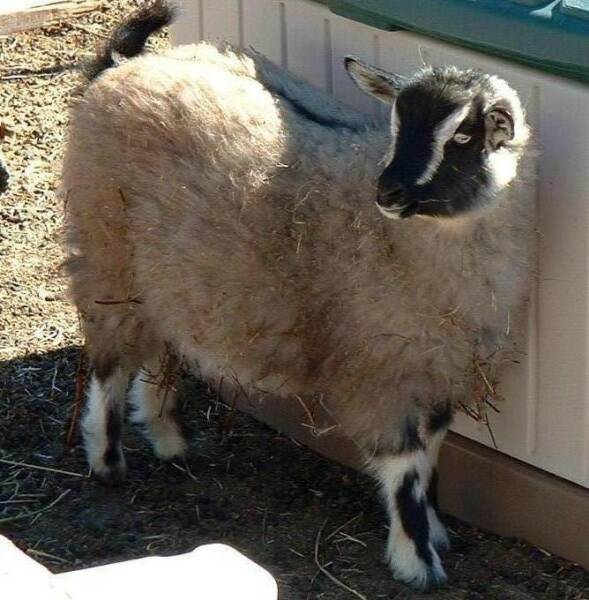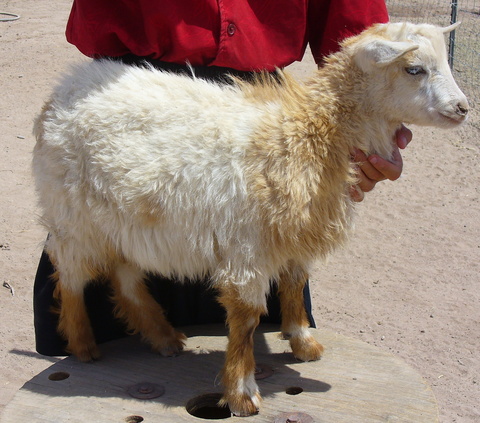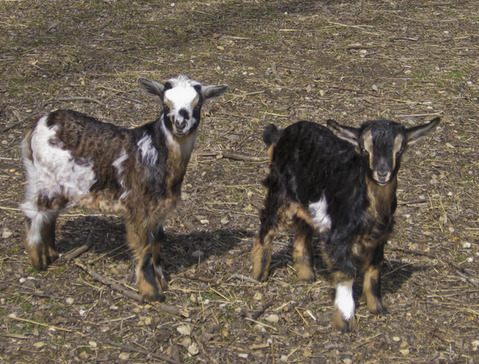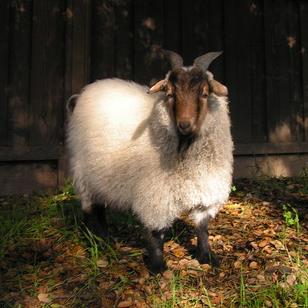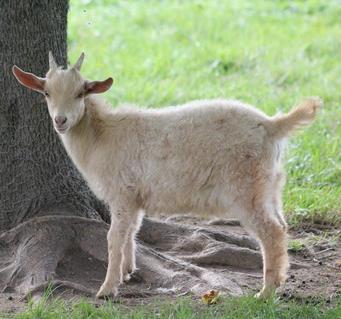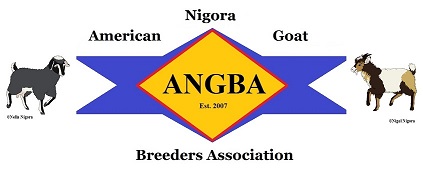Introduction, General Description, Conformation and Characteristics of the ANGBA Nigora Goat:
The American Nigora Goat Breed Standard was set by the ANGBA on
July 3, 2009 and revised on November 13, 2013
The Nigora was created to be a mid-sized, multipurpose breed; it's conformation, character and style shall be that of a healthy, well proportioned animal, capable of producing milk, as well as three distinct types of fleece, and companionship. The Nigora should exhibit a rectangular build, refinement, bone structure/substance and angularity typical of that of a well formed miniature dairy goat. Fleece amount and coverage will vary according to the breeding ratio of the Nigora and type of fleece exhibited by the animal.
Purpose: The Nigora is perfect for micro-eco niche business, Urban goat keeping, small homesteading & personal family use; they also make great pets. Nigoras are, on average, amicable little goats, their friendly dispositions and smaller size making them especially easy to handle for children and seniors.
Predominant Bloodlines: Nigerian Dwarf Dairy Goats and/or *Swiss Type Mini Dairy Breeds (i.e.: Mini Alpine, Mini Saanen, Mini Sable, Mini Oberhasli, Mini Toggenburg) and Mini Guernsey (*included in with Swiss-type for convenience) crossed with any recognized Angora goat breed (i.e.: Commercial White, Colored Angora, or Navajo/Heritage Angora). ANGBA also has Grade and Breeding Stock classifications; All goats applying for registration must meet the ANGBA minimal Standard for general breed type and be free of disqualifiable faults and/or traits. Nigoras must be a minimum of 25% Nigerian or Angora and a maximum 25% "other approved breeds" to be recorded.
ANGBA Working Standard:
Head: The ideal head is described as a blunt triangle, wide in the
backskull and tapering to a medium to medium short foreface, broad
muzzled with full nostrils and a straight strong jaw, clean-cut smooth
throatlatch. The Nigora face should have a straight to slightly dished
profile, never convex or roman nosed. Nigoras may be horned, naturally
polled, or disbudded.
Teeth: Should be flush with dental pad. When viewed from the side the
upper and lower biting structures should be symmetrical, neither over nor
undershot. Goats, other than aged seniors, should exhibit a full set of
teeth closely spaced and well set in the gums.
Eyes: Any color, bright and alert, large enough to give good expression,
not pig eyed, bulging, or squinting.
Ears: Appx. medium size, fitting nicely in proportion to goat. Carriage
may be reminiscent of either Nigerian or Angora, i.e. erect or drooping (but not pendulous) or somewhere in between (aka "airplane" ears); Should match in adult animals. On adult drop-eared goats the ears should ideally fall to the level of the corner of the mouth, and not past the jawline, when at rest. Ears longer than this will be faulted by degree of severity from minor to DQ.
Neck: Long, refined, clean-cut and blending smoothly into all body
junctions. More refined and graceful in does, heavier and showing a
distinct musculature, arch and masculinity in adult bucks
Body:
Skin: Well fitting, pliable, clean and smooth.
Frame: Rectangular in build; taller at withers than at hips, smoothly
blended throughout with and appearance of strength, balance, health
and vigor; moderate-fine yet strong bone structure.
Front end: Should exhibit arched shoulders closely attached to the
withers, which are prominent and wedge-shaped, with dorsal arising
slightly above the shoulder blades. Shoulder blade, point of shoulder
and point of elbow should have a smooth tight fit against chest wall; full
crops with moderate extension and development of brisket.
Back end- topline, rump and tail: Should be strong, straight with well
defined structure. Gentle slope downward from the withers with a level
chine, and loin that is straight and wide. Rump strong, wide, long, nearly
level to slightly sloping; drops slightly from hips to pins, wide and nearly
flat between thurls; pin bones & hip bones wide apart and well defined.
Hips nearly level with back. Tail head smoothly set slightly above pin
bones; straight, neither broken nor set awry.
Angularity: Lean and free of excess fleshing, depth and width increasing
from heart girth to rear.
Ribs, Thighs and Flanks: Ribs long, flat, flinty, widely spaced, fore ribs
well sprung, lower ribs angled toward flank. thighs, from side,
moderately incurving from pin bone to stifle; from rear, clean and wide
apart, highly arched and out-curving into the escutcheon; flank well
defined, deep, yet arched, free of excess tissue.
Chest and Heart Girth: Deep and wide, well sprung foreribs, full in crops
and point of elbow.
Barrel: Strongly supported, deep, wide and long with well sprung ribs
and increasing depth and width toward rear (with maturity).
Forelegs: Legs should be straight, strong, well-muscled, and
proportional to frame. Shoulders, knees and pasterns should be
correctly angled and strong. Forequarter movement should be free and
correct.
Hindlegs: Rear legs should be strong, well-muscled, and proportional to
frame. Hips, hocks and pasterns should be correctly angled and strong.
Hindquarter movement should be free and correct.
Feet: Hooves should be sturdy, broad, well-formed, and proportional to
frame. Inter digital division should be adequate, and both sides of each
hoof should be symmetrical
Reproductive System:
Does:
Fore udder- Wide, full to the side, moderate forward extension, free of
non-lactating tissue, blending smoothly into barrel.
Rear udder- Capacious, high, widely arched into escutcheon; uniformly
wide and deep to floor; moderately curved in side profile without
protruding beyond the vulva, blending smoothly into escutcheon.
Teats- Uniform in size, of medium length and diameter, proportionate to
udder size, cylindrical in shape, ideally plumb when viewed from the
side or rear, situated outward of center on the floor of each udder half,
orifice size to facilitate ease of milking).
Support- Strong medial suspensory ligament that clearly defines the udder
halves, contributes to desirable shape and capacity, and holds the udder
snugly against the body and well above the hocks. Lateral attachments
strong, extending well down the inside of the thigh, contributing to a large
area of attachment.
Quality- Shape, balance, & texture (globular; of adequate capacity with
due regard to stage of lactation; from the side, approx. one-third visible
in front of the leg, one-third under the leg, and one-third behind the leg;
texture soft, pliable, and elastic, well collapsed after milking, free of scar
tissue, with halves symmetrical.
Bucks:
Two testicles should be present, smooth and symmetrical, and of
adequate size for age. Any split in the scrotum should extend no more
than one third total scrotal length. Two undeveloped teats should be
present. Sheath should be normally developed for age.
Fleece:
There are three primary fleece types:
Type “A” Is a long fiber which averages 6+ inches in length. It hangs in long
lustrous ringlets or sometimes flat wavy locks. It may be a single coat (without guard hair present) but a fine silky guard hair might be present. The fiber is like very fine mohair and the handle should be cool and silky smooth to the touch.
Type “B” Is a blend of fibers which contains the characteristics of both Type "A" (mohair type) and Type "C" (cashmere type) fleece. Type "B" is usually softly curly and between 3 to 6 inches in length on average. There is obvious guard hair, though it may be finer then that found on Type "C" goats. A second silky guard hair might also be present. The fleece should exhibit luster and the handle should be fluffy, soft and lofty. The fleece on Type "B" goats is usually lighter in color than the hair coat, on average (i.e. A goat that is born black, or appears black when shed out, may grow a fleece that is either a lighter shade of brown or grey. A goat born with a dark red or brown hair coat may have a fleece that is very pale red (pink), cream colored or pale mocha).
Type “C” Is a very fine fiber and can be acceptable as commercial cashmere.
It is usually between 1 to 3 inches long but must be no less than 1 inch minimum. Type "C" has a matte finish (without luster) and a warm, creamy, suede-like handle. It must show some crimp. There is definite separation between the coarse guard hairs and fleece. Like Type "B" the fleece color is usually lighter than the guard hair color.
Color and Markings:
Nigoras may be any color and pattern.
Temperament:
As a rule, a Nigora should have a calm, naturally amiable, laid back disposition and be neither aggressive nor excessively fearful when properly socialized.
List of Known "Alternate Fiber Breeds" (Angora Based) That, When Crossed With Nigerian Dwarf or *Swiss Type or Guernsey Mini Dairy Goats, May Produce "Experimental/Grade Nigora" Eligible Offspring: (See the "Nigoras 101" page for more details)
--PBA Pygora© (Foundation breeds: Registered NPGA Pygmy x AAGBA Angora only)
--Capora (aka PCA Goat) (Foundation breeds: PBA Pygoras and their founding breeds (see above) x CAGBA Colored Angora)
--Cashgora (American or Australian Cashmere x Angora);
--Any Other Miniature Fleece Type Goats as long as they do not have any traits disallowed by the ANGBA; see the Standard and Nigoras 101 (This includes unregistered Pygmy/Angora crosses, which according to the PBA may not be called Pygoras© if they are NOT registered with them.)
Whenever possible try to select your Nigora breeding stock from allowed goat breeds from documented bloodlines. If certain breeds are absolutely
not available in your area (i.e.: Angoras) but you are able to obtain one of the
approved alternatives (i.e.: Caporas or Pygoras) then you may feel free to start with a Grade Nigora program using the above as a guideline. When choosing
an alternate fiber breed, try to obtain ones that are mostly Angora in breeding,
i.e. 3/4 Angora) and always choose goats with a build/ conformation that is as close to the Nigora standard as possible (i.e.: Caporas or Pygoras with body type closer to the longer bodied Angora are more desirable than the cobby Pygmy).
**Nigerian-Pygmy crosses (sometimes called "Pygerians") and mixed Swiss-type Mini Dairy goats (i.e.: Mini Alpine x Mini Oberhasli) may be used in a Grade Nigora breeding program**
NOTE: When Nigoras reach a proliferation of F6 individuals the registry will officially open. The Record will remain open to F1-F5 Nigoras. Once the registry opens Nigoras from alternate fiber goat breeding will be categorized as "Experimental/Grade". Nigoras from unknown breeding that meet the standard will still be be recorded as "NOA/Grade".
Disqualification From Recordation/Registration:
Any goat exhibiting severe, heritable conformational defects which would affect its ability to be a good breeding animal and any goats exhibiting Non-Nigora specific breed traits, i.e.:
--Excessive height over 29"
--Excessively meaty frame/bulky build or very heavy bone (*Boer, Kiko, other
meat breeds)
--Extremely stumpy legged with barrel shaped body
--Long pendulous *Nubian-type ears
--Very tiny *LaMancha type ears
--Myotonia/Fainting (*Fainting goat- Tennessee Wooden Leg goat, etc.)
--Complete lack of fleece (a "Slick")
--Excessively long straight silky coat of guard hair with or without discernible undercoat/cashmere (*Mini Silky Fainting goat)
--Roman nosed (*Nubian and/or Boer)
*Severe Faults/**Disqualifications:
**Deformed mouth
*Swayed back (not caused by old age), **Roached back, **Spinal deformity
*Weak conformation; lacking depth, slab sided or narrow body type
*Serious emaciation; unthrifty constitution
**Blindness (not caused by injury)
*Permanent lameness; broken down pasterns, deformed and crooked
feet and/or legs
**Blind (non-functioning) udder half
**Blind teat
**Double teat (bifurcal, or fused)
**Extra teat that interferes with milking (supernumerary); *non-interfering extra teat
**Extra teat on buck (supernumerary)
**Double orifice on buck
**Crooked face
*Active mastitis or any other cause of abnormal milk
**Evidence of hermaphroditism
**Evidence of any inability to reproduce
**Anything other than two normal, fully descended testicles in bucks;
more than 3-inch split in scrotum
**Permanent physical defect from birth
**Excessively Over height
*Excessive long coarse guard hair throughout, which may obscure fleece; **Long silky coat of straight hair, which may or may not obscure and undercoat of cashmere.
Please contact ANGBA for permission to use any Assoc. content found on this site. Thank you!
"Farmhouse Acres Bette"
Adult Nigora Doe
"AngoraMoon (MA) Sandstorm"
Junior Nigora Buck
The above goats are representative of desirable Nigora type
"Artos Fiona and Shrek"
4-week-old Nigora kids
"Artos Roux"
Adult Nigora Buck
"Wiseoaks Coconut"
Adult Nigora Wether
Junior Nigora Doe bred by KeepEmGoin Farm
ANGBA STANDARD OF THE NIGORA GOAT
MAINTENANCE MODE
